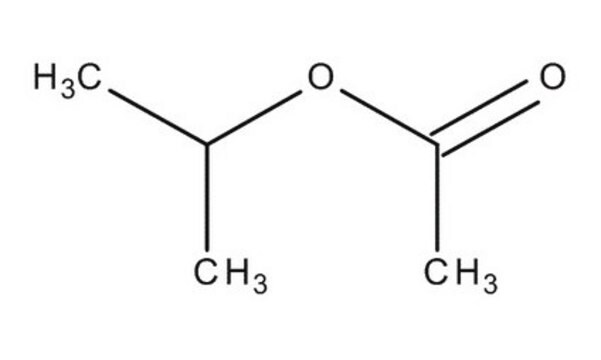90871
Essigsäureisopropylester
analytical standard
Synonym(e):
Isopropylacetat
About This Item
Empfohlene Produkte
Qualität
analytical standard
Qualitätsniveau
Dampfdichte
3.5 (vs air)
Dampfdruck
47 mmHg ( 20 °C)
Assay
≥99.8% (GC)
Selbstzündungstemp.
894 °F
Haltbarkeit
limited shelf life, expiry date on the label
Expl.-Gr.
1.8 %, 37 °F
8 %
Methode(n)
HPLC: suitable
gas chromatography (GC): suitable
Brechungsindex
n20/D 1.377 (lit.)
n20/D 1.377
bp
85-91 °C (lit.)
mp (Schmelzpunkt)
−73 °C (lit.)
Dichte
0.872 g/mL at 25 °C (lit.)
Anwendung(en)
cleaning products
cosmetics
environmental
flavors and fragrances
food and beverages
personal care
Format
neat
SMILES String
CC(C)OC(C)=O
InChI
1S/C5H10O2/c1-4(2)7-5(3)6/h4H,1-3H3
InChIKey
JMMWKPVZQRWMSS-UHFFFAOYSA-N
Suchen Sie nach ähnlichen Produkten? Aufrufen Leitfaden zum Produktvergleich
Allgemeine Beschreibung
Anwendung
Empfohlene Produkte
Signalwort
Danger
H-Sätze
Gefahreneinstufungen
Eye Irrit. 2 - Flam. Liq. 2 - STOT SE 3
Zielorgane
Central nervous system
Zusätzliche Gefahrenhinweise
Lagerklassenschlüssel
3 - Flammable liquids
WGK
WGK 1
Flammpunkt (°F)
41.0 °F - closed cup
Flammpunkt (°C)
5 °C - closed cup
Choose from one of the most recent versions:
Besitzen Sie dieses Produkt bereits?
In der Dokumentenbibliothek finden Sie die Dokumentation zu den Produkten, die Sie kürzlich erworben haben.
Kunden haben sich ebenfalls angesehen
Artikel
Learn about analyzing organic volatile impurities (OVIs) in pharmaceuticals using SH-GC, focusing on suitable solvents and ensuring compliance.
Unser Team von Wissenschaftlern verfügt über Erfahrung in allen Forschungsbereichen einschließlich Life Science, Materialwissenschaften, chemischer Synthese, Chromatographie, Analytik und vielen mehr..
Setzen Sie sich mit dem technischen Dienst in Verbindung.




![1,8-Diazabicyclo[5.4.0]undec-7-en (1,5-5) 98%](/deepweb/assets/sigmaaldrich/product/structures/120/564/5b373e23-1624-489c-8efb-692de0f96ffb/640/5b373e23-1624-489c-8efb-692de0f96ffb.png)












